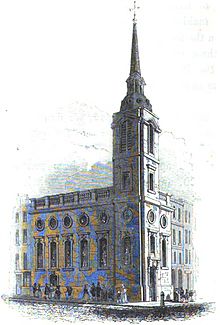St Benet Gracechurch
| St Benet Gracechurch | |
|---|---|

St Benet Gracechurch in the 1820s
|
|
| Location | Gracechurch Street, London |
| Country | United Kingdom |
| Denomination | Anglican |
| Previous denomination | Roman Catholic |
| Architecture | |
| Demolished | 1868 |
St Benet Gracechurch (or Grass Church), so called because a haymarket existed nearby (Cobb), was a parish church in the City of London. First recorded in the 11th century, it was destroyed in the Great Fire of London of 1666 and rebuilt by the office of Sir Christopher Wren. The church was demolished in 1868.
The church was in Bridge Ward, on the corner of Fenchurch Street and Gracechurch Street.
'St Benet' is short for 'St Benedict' and St Benet Gracechurch was one of four churches in pre-Fire London dedicated to St Benedict of Nursia, the 6th century founder of Western monasticism. Gracechurch meant “Grass Church”, referring to the site of a hay market nearby.
The earliest surviving reference to the church is in the 1053 Charter of Brihtmaer conveying a church in Gracechurch Street to Christ Church, Canterbury. The dedication to St Benedict is first recorded during the reign of Henry III.
In 1553, at the beginning of the reign of Mary I, the churchwardens paid 3s. 4d. to a plasterer to remove the Biblical texts painted on the interior walls during the time of her Protestant brother Edward VI. Shortly afterwards, church records recount that a Te Deum was sung "for the birth of our Prince (which was thought then to be)" – a reference to one of Mary’s phantom pregnancies. The steeple was rebuilt in 1625. There were further alterations in 1642 when, for religious reasons, the "popish altar cloth" and "superstitious brasses" were sold. The cross was taken down from the steeple and a workman was paid "for defacing superstitious things in the church".
According to John Strype, the church was repaired and beautified in 1630 and 1633. Stow or Strype mention various tombs there, including that of the Chamberlain of London John Sturgeon (d. 1571), and also a monument to Queen Elizabeth I.
...
Wikipedia
